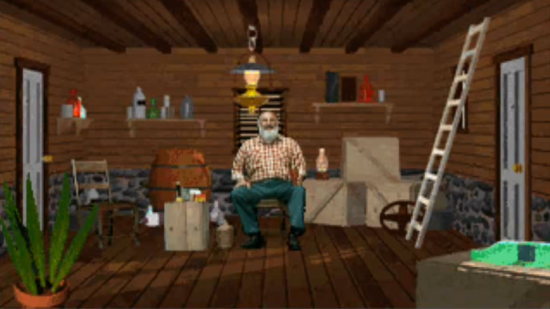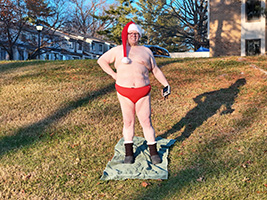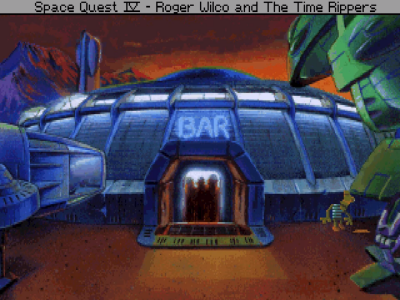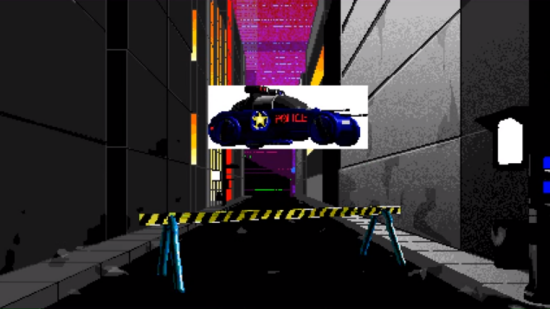Reliving the nineties, one adventure game at a time…
9 minute read
April 30, 2018, 2:25 PM
Lately, I’ve been reliving the computer games that I used to play in the nineties through the magic of YouTube. I was a Sierra gamer for the most part back in the day, mostly playing in the Space Quest franchise. I used to love exploring around the worlds that the game created, hoping to make some sort of breakthrough in the game to advance the plot.
Interestingly enough, my first introduction to Sierra was not through an adventure game. I played Hoyle’s Official Book of Games, Volume 1, which consisted of six card games: Crazy Eights, Old Maid, Hearts, Gin Rummy, Cribbage, and Klondike solitaire. The game introduced the player to various Sierra franchises, as well as some other folks, via the various characters that you could play against. You could play against Princess Rosella and King Graham from King’s Quest, Roger Wilco from Space Quest, Sonny Bonds from Police Quest, and Leisure Suit Larry from the series of the same name. There were also a few real people, such as Jerry Moore, who was one of the animators, and Warren Schwader, who programmed the game. Jerry and Warren’s kids, Devin and Christina, respectively, were also in the game. I learned a lot from that game. I learned how to play several card games, plus I learned about a number of other Sierra franchises by playing cards with their characters.
At the same time as the Hoyle game, I also had King’s Quest IV, which featured Princess Rosella, whom I knew from playing cards. I didn’t do too well with that game, though, because I didn’t know that it had a text parser interface – and who reads instructions? I thought it was all point-and-click like Hoyle was. So I would just wander around aimlessly and eventually either get bored with it or die, either by falling off one of the cliffs, or by getting caught by one of the trees.
Then when my family moved to a Virginia, I discovered my niche in the adventure game segment: Space Quest IV, which was more my style, i.e. lighthearted and funny, while still telling a pretty good story. Space Quest IV had lots of things that amused eleven-year-old me, such as a creature stumbling out of a bar, throwing up, and subsequently stepping in it:
I remember my mother’s taking away my Space Quest one time because I described that scene to someone. I thought it was hilarious, but my mother has never been one for bodily function humor. Thus, as punishment… you know. I still think it’s hilarious.
Getting through that game was fun, and it was also a bit of a family thing, as Dad occasionally got into it, as he was the one who found the entrance to the sewer, and then he also later figured out how the bird picks you up and you get caught by the Latex Babes of Estros. Dad advanced all the way to the mall part, and then I took it from there. That was a good, solid game. And who would have ever thought that a space adventure game would land you in a shopping mall?
Around this time, I also played with Leisure Suit Larry 2. That game was probably a little too mature for me at the time, and the humor wasn’t as good as Space Quest. I also felt like Larry was just a sleazy guy who bumbled his way through the game while being insulted and mistreated by everyone along the way. All that said, I never touched another Leisure Suit Larry game, because I wasn’t that interested.
I got the CD versions of Space Quest IV and King’s Quest V around the same time in 1995. Both games were “talkies” (i.e. all of the dialogue is voiced) in their CD versions, but King’s Quest, for the most part, played the adventure genre straight, which made for a less entertaining game. The narrator gave a very dry presentation, and there was very little humor in the game. Compare to Space Quest, where they got Gary Owens to narrate. It was definitely not a dry presentation with Gary Owens narrating, that’s for sure.
Then I later got Space Quest V. That game was significantly different from the previous game, both graphically and in play style. Now, Roger Wilco was training to be captain of his own ship, and eventually achieved that position, albeit by a computer glitch. As such, the game sent you on various missions as you completed your quest, which started out routine, and led to Wilco’s saving the galaxy from a mutagenic disease caused by a product dumped by the “Sludge Bandits”. The latter half of that game always creeped me out just a little bit. Something about seeing those mutants, and the way they would attack you with their goo whenever they found you just gave me the heebie-jeebies. I mean, this face just says it all:
Nightmare fuel, right there. And as it turned out, that guy, Captain Quirk, was also a big player in the dumping of toxic waste. In the end, he got infected by his own goo (the result of which you see in the above image), which led to his undoing. That game certainly had its frustrating moments, though. Specifically, the part where you have to rescue Cliffy, your chief engineer, after he floats away while repairing the ship. You had to be very precise to get through that part of the game, and if you ran out of either fuel or oxygen, your craft would fall to a nearby planet, and there was a long scene before you were given the option to restore:

“Ah, look, Crumpella, a shooting star. Make a wish.”
“Ok, Slep. I wish… I wish… I wish we would discover someone else out there among the stars…”
“Don’t be silly, Crumpella! Everyone knows there’s no intelligent life out there!”
Yes, the game mocks you all over the place when you make a mistake. That does start to get old when you’ve tried for what feels like the hundredth time to get Cliffy and bring him back to the ship. If you run out of fuel or oxygen during either part of it, you get to watch Crumpella and Slep – again – before the game tells you, “Fuelish human! You ran out of gas!” and gives you the option to restore.
Then there was Space Quest 6, which I got in 1995. The gameplay was not as good as the previous two installments, and the graphics were a bit too cartoony for my liking. The game also had a very slow start. After the introduction, where Roger is busted back down to janitor for the events of the previous game, a brief scene of the main villain, and then everyone on Roger’s new ship’s being given shore leave on the planet Polysorbate LX (named for a food emulsifier), you start out doing random things for people, which eventually nets you enough money to get a hotel room. Only then does the real story begin, as two thugs knock you out and hold you captive with the intent of stealing your body. I do give that game credit, though, for teaching me some new words: “churlish”, which means “rude in a mean-spirited and surly way”, and “burlesque”, which is “a variety show, typically including striptease”. In the game, there were chips called “moddies” that some beings could put in their bodies to change their behavior. One moddie was labeled “churlish”, and another “burlesque”. You had to peel the label off of the churlish moddie and place it on the burlesque moddie in order to get rid of one of the two thugs. When you did it all correctly, he inserts the moddie just behind his neck, and then strips down to his g-string and dances off, leaving you alone to complete your next puzzle. If you give the guy the real churlish moddie, he just beats you senseless and that was that.
I also really got into two non-Sierra games during this time. The first was one that my cousins got me into: Spaceship Warlock, which is by Reactor. It wasn’t a bad game, but I plowed through it fairly quickly, and was disappointed when I realized that I had finished the game. I could have gone on for longer. It played space a bit straighter than Space Quest, but it worked. The graphics were very nice for the time, with everything rendered by computer. They look a bit dated now, but such is what happens with technology. There was also this animation of a police car, surrounded by a white box:
Something tells me that in a perfect world, the police car wouldn’t be boxed in like that. I wonder if that was a technical limitation. I imagine it was, because the end result looks like an unfinished product.
I never got into any other Reactor games, mainly because their flagship product was Virtual Valerie, which was, to put it nicely, not something that you should buy a 13-year-old boy.
The other non-Sierra game that I really got into was Return to Zork, which was an Infocom game. That was a fun little point-and-click adventure that Mom forbade me from playing at one point because of one scene:

“Want some rye? ‘Course ya do!”
Yes, Boos. You had to get him drunk, get his keys, and then get him to fall over in order to reveal the entrance to the underground world. Mom didn’t approve of that, and so what that meant was that my friend and I couldn’t play it at my house. We’d just go to his house down the street and play it there. Mom has always tended to do that, judging a whole body of work based on one element, and it doesn’t always serve you well. The alien puke in Space Quest IV is another good example. I found it a little insulting at the time, because it didn’t give me any credit for understanding reality vs. fiction. I knew that the games were pretend, and thus it was okay to laugh at those things because that’s what they were put in there for. And in Zork, if you did something really bad, like kill someone, the game issued a swift punishment. The same idea of Mom’s judging a whole based on one thing didn’t just apply to fiction, though. For years, Mom judged Roscoe Orman, the actor who played Gordon on Sesame Street, for playing a much more adult character on All My Children when he was also working on a children’s show. I put that discussion to bed many years later when I said, “Actors have to eat, too, you know.”
In any case, that game, which Mom eventually let back into the house, gave me many hours of enjoyment as I explored the game’s world. Like in Space Quest 6, I learned a new word: guano. In that case, you have to release some bats in order to get through the Whispering Woods. They would leave their droppings as they flew, and that was how you completed that part of the game. Then you picked up some of the bat guano and used it later to make an invisibility potion.
Watching all of these games again recently on YouTube has given me some new perspective on things, especially with Space Quest. When I first played these games, I was too young to connect all of the dots (as well as get all of the jokes). In Space Quest V, it all became clear how the plot came about and how it all unraveled. Captain Quirk was being bribed by the Genetix Research Corporation, which was dumping the result of a failed experiment in a certain area of space. Then the product eventually got out from one of the dumping sites and infected the inhabitants of a nearby colony. When they launched in their shuttle, Quirk’s ship, the SCS Goliath, recovered it, and that caused the ship’s crew, Quirk included, to become infected. We were given clues to this early on in the game’s mission, where Roger’s ship intercepted a mysterious transmission, and then we saw Quirk sitting with the same being that we saw in the transmission. There’s an additional clue if you go to Genetix before you’re supposed to: the same being from the transmission will hail your ship and tell you to leave immediately. Then the next game shows exactly how corrupt Starcon is, as they harshly punished Roger for once again saving the universe, and then everyone from some of the highest levels were complicit with the whole body snatching thing that formed the main story of the game. So much corruption, complete with the faked death of a crewmember. It’s too bad there was no Space Quest VII, because I would have loved to have seen the fallout from the events of the sixth game.
I’ve also explored some of the fan games. Someone made a VGA remake of Space Quest II using the Space Quest IV game engine, and the result is pretty good. The writing needs to be cleaned up a bit, but all in all, it’s pretty faithful to the original. The soundtrack is a bit underwhelming for a Space Quest title, but it’s hard to top Gary Owens’ performance. The narrator in this game reminds me of King’s Quest V and its rather dry delivery. Then there’s Space Quest IV.5, which attempts to bridge the gap between Space Quest IV and Space Quest V. It tries to explain how Roger ended up as a cadet at Starcon Academy, and why Zondra, a character in the Space Quest X era, was trying to kill him. The game is pretty boring, mostly spent running back and forth between several locations, and then ditching the character from Space Quest X in a wedding scene. Additionally, Roger argues with the narrator, which doesn’t appear in the official games until Space Quest 6 (thus it’s out of place). I consider this between-games sequel unnecessary, as it doesn’t meaningfully advance the story. I also always assumed that Zondra’s desire to torture or kill Roger stemmed from something that occurred in the “real” Space Quest X game, which we had not seen (because it wasn’t made), and that what we saw in the fourth game occurred after the events of the “real” game.
All in all, I would love to see the Space Quest series restarted in a real manner, but I imagine that it will never happen. Oh, well.
In any case, I’ve enjoyed reliving these old games from the nineties. Such fun. It’s too bad that Sierra isn’t really around anymore to make more of these things.
Categories: Video games












